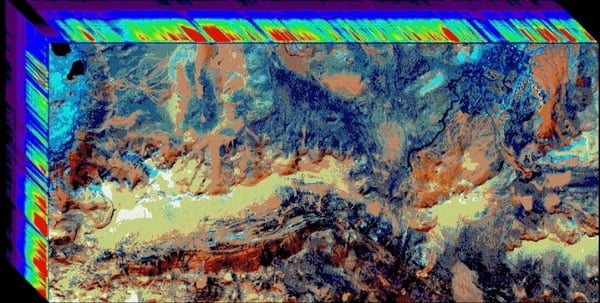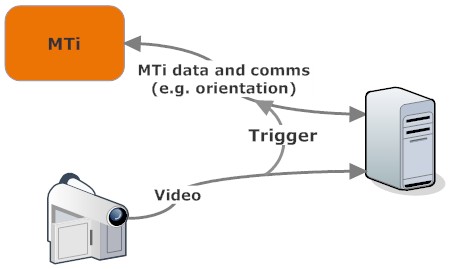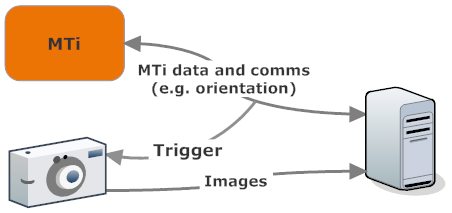3D motion tracking technology benefits a wide range of industries. By providing crucial information on device orientation, motion, and location, motion tracking technology enables system engineers to capture data that is more accurate and detailed than ever before.
Sharing that data effectively between the Xsens motion sensor (IMU, VRU, AHRS or GNSS/INS) and other devices often requires platforms to be in sync. The Xsens MTi motion tracking products provide six synchronization functions to make integration with your platform a cinch.
Before we discuss those in detail, let’s take a look at how synchronizing with other devices can benefit a wide range of industries and applications.
Typical Applications
To illustrate the need for synchronization, the following five examples represent applications where motion tracking data must be correlated with other datasets.
Drone-Based Applications
Drones are becoming increasingly valuable tools for a large number of government and private sector industries. Many of these applications involve the use of drone-mounted cameras or other imaging devices for gathering the needed data.
For example, law enforcement agencies use drone cameras to help locate suspects, assess crime scenes, and for search and rescue operations. In each of these applications, it is crucial that agencies not only have visual information from the targeted area, but accurate location data, as well. In many cases, having real-time GNSS coordinates of the location being observed can mean the difference between life and death.
 In applications such as these, connecting GNSS data to augmented reality (AR) software can enable an agency to see street addresses and landmarks graphically overlaid on the camera image.
In applications such as these, connecting GNSS data to augmented reality (AR) software can enable an agency to see street addresses and landmarks graphically overlaid on the camera image.
Land surveying is another application where drone-mounted cameras must be in sync with GNSS data. Whether regular HD cameras or UAV photogrammetry is employed, highly granular GNSS coordinates must be integrated with the imaging apparatus in order to produce detailed and accurate maps.
The MTi-G-710, with GNSS 1 PPS capability, is ideally suited for meeting the tight requirements of these and similar applications.
Maritime Vessels
In addition to tracking geolocation, motion tracking devices have another application within the vessel monitoring system (VMS) of large maritime vessels—detecting how the craft responds to wave action. By placing MTs in fore, midship, and aft locations of a cargo ship, for example, ship engineers can gather valuable data about how the dynamic forces of the waves are affecting various parts of the vessel. Since a large hull twists and flexes in response to the waves, these motions can provide important information about the vessel's performance.

Getting the most useful information from such data requires synchronizing the various motion tracking devices with one another. By ensuring that clock signals of all devices in the array are in sync, the data retrieved will provide an accurate real-time picture of the forces acting on the structure of the ship.
Aeronautics
Similar to wave action upon a ship, aerodynamic forces cause the wings of large aircraft to flex during flight. By using a series of motion tracking devices, located throughout the wings, the dynamic forces acting upon the craft can be accurately measured—if the clocks and data streams are properly synchronized.
Seabed Mapping
Mapping of harbors, inland waterways and shipping channels provides valuable information needed to ensure safe marine navigation. Multibeam echosounders make high-resolution mapping of seabeds possible using multiple acoustic beams formed into a fan pattern.
Motion tracking devices, such as the Xsens MTi product line, ensure that map data accurately corresponds to the location being mapped. By synchronizing mapping software with motion tracking data, a precise correlation between geolocation and map data is assured.
Hyperspectral Imaging
Hyperspectral imaging devices collect information from across the electromagnetic spectrum when viewing a target, as opposed to traditional cameras that see only within the visible light spectrum. Agriculture, geoscience and mineralogy, environmental impact studies, and fuel exploration benefit greatly from the information hyperspectral imaging provides. As with seabed mapping, motion tracking devices with synchronization are used to ensure that imaging software plots graphical data accurately in relation to the area being scanned.

MTi specific functions
The Xsens MTi 1-series, MTi-7, MTi 10-series, MTi 100-series and MTi-G-710 offer outstanding motion tracking performance, along with versatile synchronization functions. Not all sync functions are available on every device, but the MTi product line includes the right combination of performance and synchronization functions to provide a solution for almost any application.
SendLatest
The SendLatest input instructs the MTi to send its latest data, ensuring that the device requesting the data is ready to receive it.

TriggerIndication
TriggerIndication is simply a flag that appears in the outputted data packet when the MTi device has been triggered. This function is useful for applications where a computer or other device needs to know that another device in the system has triggered the MTi.
SyncOut (Interval Transition Measurement)
The SyncOut function, also referred to as Interval Transition Measurement, is used to trigger an external device. The outputted trigger signal can be based on the MTi clock, but can be configured to occur at the specific intervals needed by the receiving device.

ClockSync (Clock Bias Estimation)
Even though the internal clocks of MTi devices are highly stable, some applications require the MTi clock to be synced to a more-precise timing standard. The ClockSync function is used for this purpose. Also, this function is used when the external device cannot sync with the MTi using the SyncOut function.
StartSampling
An external device may need the MTi to begin sampling at a specific time, or at specific intervals. The StartSampling function allows those devices to instruct the MTi to begin sampling when the external device is ready for the data.
GNSS 1 PPS
A simple but useful function, the GNSS 1PP function outputs a 100 μs pulse as received directly from the GNSS receiver. This function is available only on MTi-G-710s with hardware version 3.x.
The Xsens article Synchronization with the MTi explains the six functions available on MTi products in more detail.
Conclusion
Synchronization capability is crucial for many 3D orientation sensor applications, especially where precise imaging devices are involved. The Xsens MTi family of 3D orientation sensors provide world-class motion tracking performance, with flexible synchronization functionality.
--
Download the free Whitepaper
Xsens has a free whitepaper available that explains the MTi System Architecture: "The Next Generation Xsens Motion Trackers for Industrial Applications".
It reveals in great detail what happens inside the orange box.
So in short it explains more on the:
- MTi System Architecture
- Applications
- Algorithm Engine
- MTi Portfolio
After submitting the form you will receive a download link to the Whitepaper.
